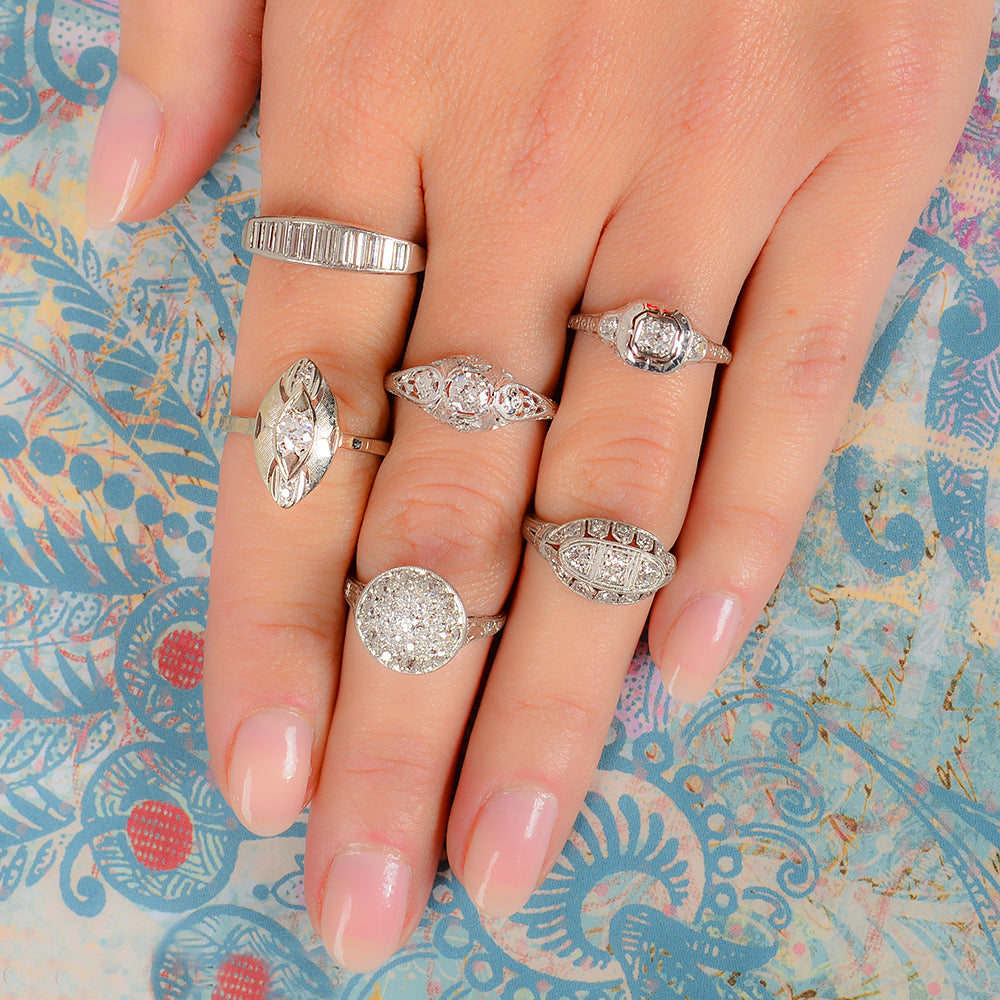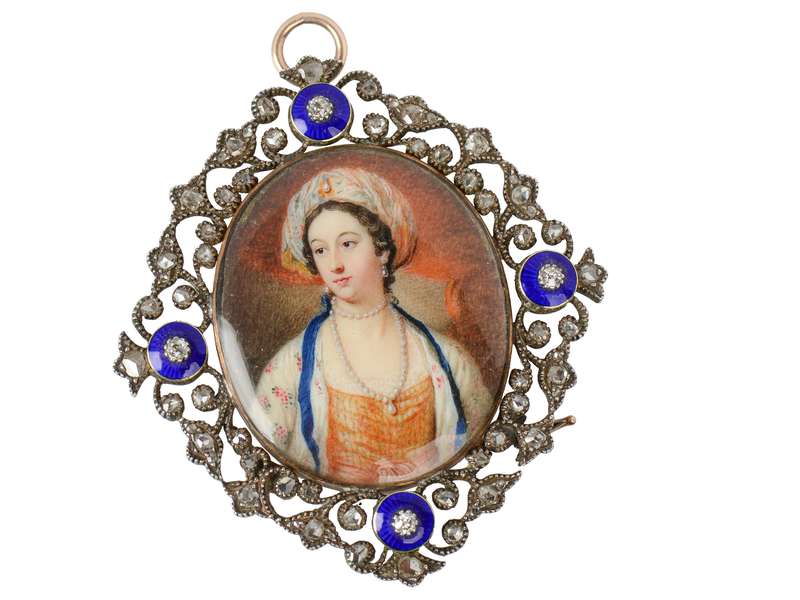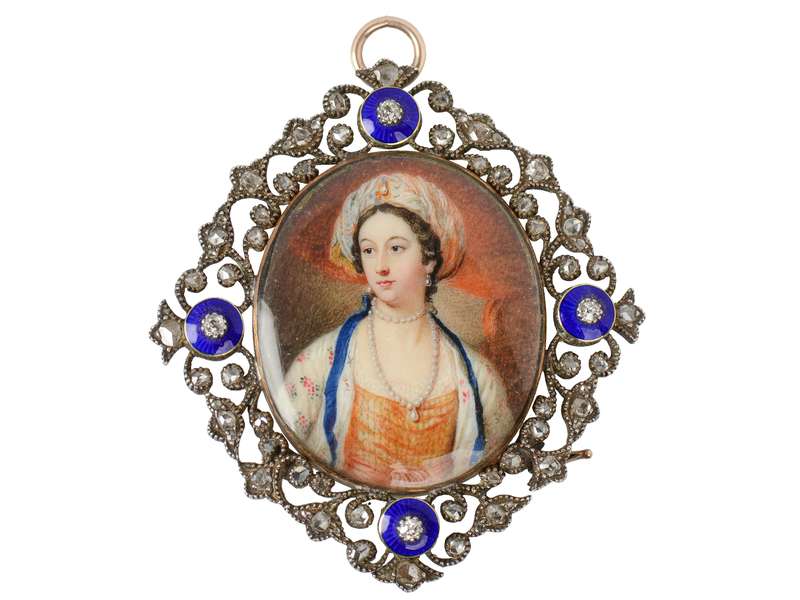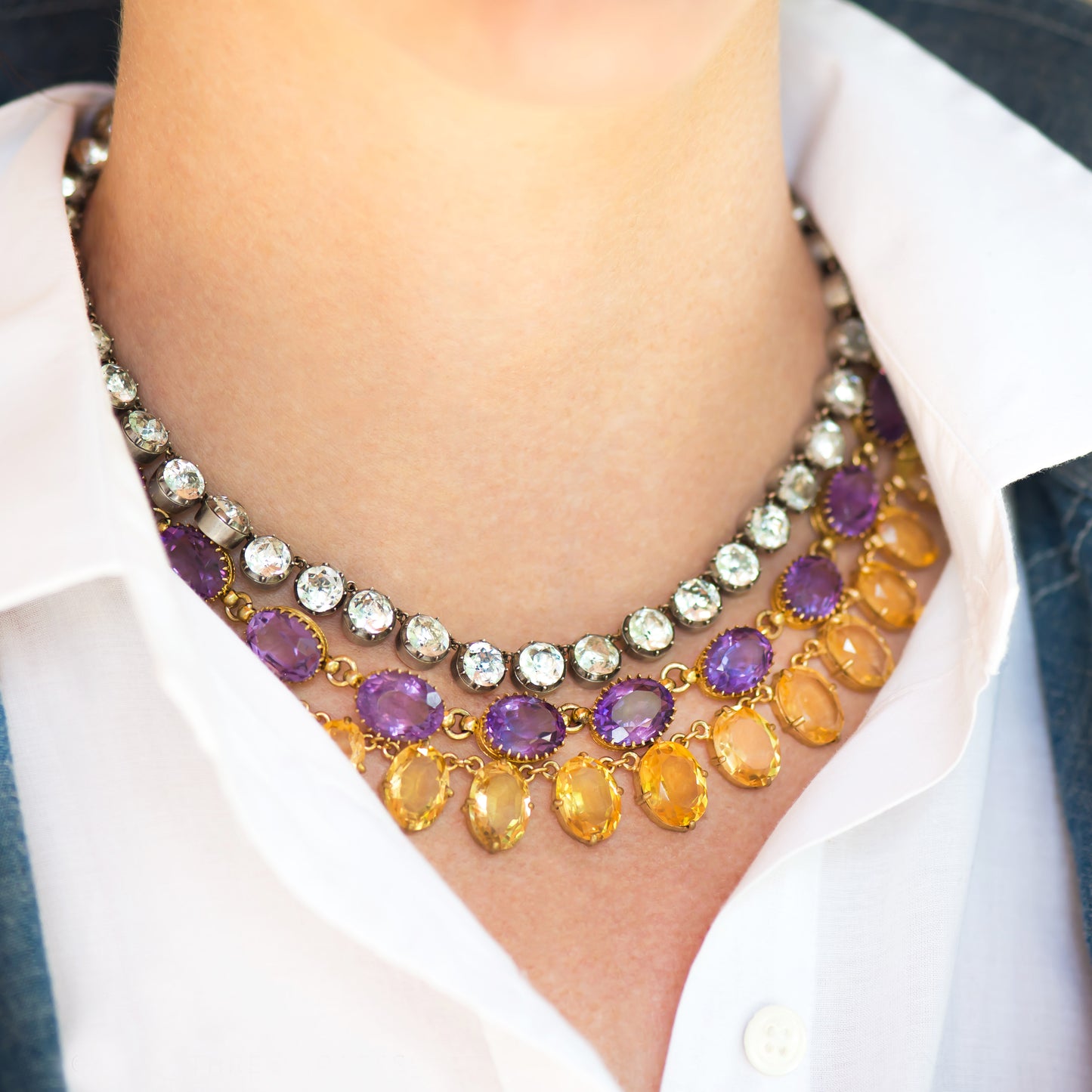
Lady Mary Wortley Montagu Portrait Miniature in Box
The Three Graces is pleased to present a remarkable and historical miniature portrait with hair work reverse.
In the image of the renowned Lady Mary Wortley Montague (née Pierrepont) comes this museum-worthy treasure. Arrayed in her Ottoman finery, she is depicted replete with an elaborate turban hung with an impressive pearl, an exotic costume, pearl earrings, and an enviable strand of pearls.
Of the highest order, the quality of the hand painting is unmistakable and evident. A palette of muted sienna, umber, warm grays, skin tones, and rich cool Aegean blues was utilized. Her brown eyes gaze left.
A lavish frame of silver, studded with rose-cut diamonds, is punctuated by four roundels of cobalt blue enamel. These are topped with crimped collet-set rose-cut diamonds.
To the reverse, a breathtaking miniature is composed of an artfully arranged plume of hair (likely her own). An oval of blue glass serves as the base for the initial "P" demarcated in an elaborate script, signifying her maiden name. There is a surround of teeny tiny pearls (some likely glass or similar).
Braided wire and twisted hair in undulating forms are placed at the bottom. To the outer edges, these are shaped into stalks, possibly in a wheat motif.
All of the is arranged atop a pearlized, opalescent glass patterned with a burst of rays from its center. Glazed with glass, the frame is engraved with rose gold.
In a setting of primarily silver, a gold fold-up-and-down ring is original, as is a later gold brooch fitting and bases. This can be worn (albeit this is a larger miniature) suspended on a chain or as a brooch. It is perfect for a cabinet display or hanging on the wall.
Comes with an 18th century Moroccan red leather case, with cream silk interior and "C" hook closure. Rare and fine.
Historical Notes:
Lady Mary Wortley Montagu (nee Pierrepont) lived was born May 15, 1689 and passed on August 21, 1762. Famed as a remarkable woman of her time, she was an English aristocrat, poet, and writer as well as an advocate for women's rights.
Married in 1712 to Edward Wortley Montagu, he later served as the British ambassador to the Sublime Porte. Her travel writings are exceptional as she accompanied her spouse through the Ottoman Empire for a period of two years.
Her writings include the book, "Turkish Embassy Letters", first published after her death in 1763. Anonymously she wrote a periodical " Nonsense of Common-Sense", in support of the Robert Walpole government.
Many others have written about her, and her poetry is also in print.
An advocate on many levels, she championed smallpox inoculations in Britain. Much is written about her, her life, and her writings. To note even a small fraction is beyond the scope of these highlights.
Please also research her other portraits and those inspired by her, often with similar exotic dress.
FREE WORLDWIDE!
Lightning Fast
Most purchases ship the same day if purchased by noon Eastern.
Shipping occurs M-F and arrives M-Fri or Sat by USPS.
Shipments are anonymous for surprises and gift-giving.
DOMESTIC METHODS



FREE 2-3 DAY via UPS, FedEx, or USPS.
- A physical address and phone number are required.
- IMPORTANT: A signature is required for insurance
- If missed, redelivery occurs the following day.
HOLD OPTIONS
Hold at FedEx hold locations. A photo ID of the addressee is required.
USPS hold at your local post office.
UPGRADED OPTIONS CHARGES
2 Day morning delivery. Usually by 10:30 am. $35—to major areas
Overnight—$35
Priority Overnight Usually by 10:30 am—$45
Saturday Delivery—$50
INSURANCE
GRATIS! Every package is fully insured by a specialized jewelry insurance carrier. You receive a full refund right away if lost, damaged, or stolen. Contact us immediately! Remember, after shipping thousands of packages a year since 2002, problems are very rare.
HOW IS MY JEWELRY BOXED?
A lovely hand-made Italian gift box with a fabric ribbon is provided. Please refer to this page for photographs and more information.
FREE RETURN SHIPPING
If for any reason you are not happy with your purchase, even returns are free from anywhere within the US. Visit the Returns section for details. Our apologies, but due to customs forms and regulations, international buyers pay for return shipping.
INTERNATIONAL SHIPPING


Express service fee is $75, fully insured via UPS or FedEx, 2-7 day service.*
Contact us to receive an estimate for any taxes, duties, or fees.
*Custom's clearance times vary.
FREE WORLDWIDE!
Lightning Fast
Most purchases ship the same day if purchased by noon Eastern.
Shipping occurs M-F and arrives M-Fri or Sat by USPS.
Shipments are anonymous for surprises and gift-giving.
DOMESTIC METHODS



FREE 2-3 DAY via UPS, FedEx, or USPS.
- A physical address and phone number are required.
- IMPORTANT: A signature is required for insurance
- If missed, redelivery occurs the following day.
HOLD OPTIONS
Hold at FedEx hold locations. A photo ID of the addressee is required.
USPS hold at your local post office.
UPGRADED OPTIONS CHARGES
2 Day morning delivery. Usually by 10:30 am. $35—to major areas
Overnight—$35
Priority Overnight Usually by 10:30 am—$45
Saturday Delivery—$50
INSURANCE
GRATIS! Every package is fully insured by a specialized jewelry insurance carrier. You receive a full refund right away if lost, damaged, or stolen. Contact us immediately! Remember, after shipping thousands of packages a year since 2002, problems are very rare.
HOW IS MY JEWELRY BOXED?
A lovely hand-made Italian gift box with a fabric ribbon is provided. Please refer to this page for photographs and more information.
FREE RETURN SHIPPING
If for any reason you are not happy with your purchase, even returns are free from anywhere within the US. Visit the Returns section for details. Our apologies, but due to customs forms and regulations, international buyers pay for return shipping.
INTERNATIONAL SHIPPING


Express service fee is $75, fully insured via UPS or FedEx, 2-7 day service.*
Contact us to receive an estimate for any taxes, duties, or fees.
*Custom's clearance times vary.
 Authenticity Guaranteed
Authenticity Guaranteed
 Fast Shipping
Fast Shipping
 No Question Returns
No Question Returns

Breathtaking Engagement Rings
As distinctive as you are, every engagement and wedding ring is unique and handpicked for its aesthetics, condition, and authenticity. Filigree work, cluster or halo rings, three stones, wedding sets, diamonds or fine gemstones - you will know it when you see it.
Experience The World of The Three Graces
Trust & Honesty
Testimonials
The Three Graces adds a personal touch with absolute professionalism that makes every interaction special.
I have been buying here more than a decade. An ever-changing collection that feels curated, carefully chosen, always high quality.
It never ceases to amaze me how every lovely piece of antique jewelry is so immaculate and ageless.




















